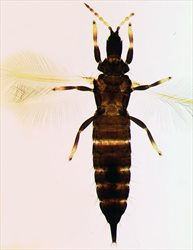
Female
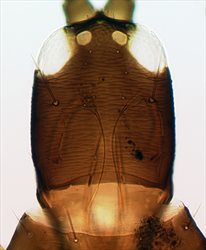
Head

Antenna

Antenna
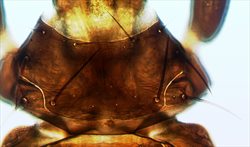
Pronotum
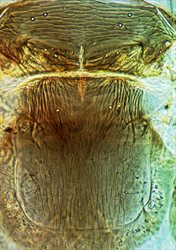
Meso & metanota
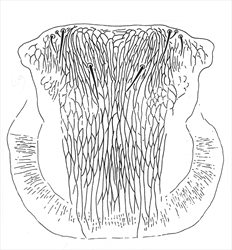
Metanotum
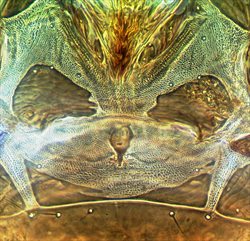
Prosternites
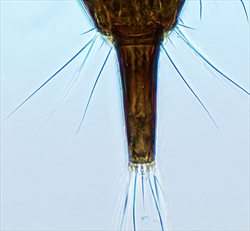
Segment X (tube)
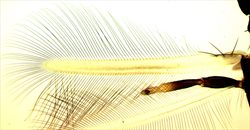
Fore wing

Hind tibia & tarsus
Both sexes fully winged. Body and legs brown, tarsi and fore tibiae yellow also distal third to distal half of mid and hind tibiae; antennal segment II brown, III and IV largely yellow, V and VI variably yellow in basal half; major setae dark brown, tergite IX setae paler; fore wing shaded at base then with a longitudinal dark line medially and also shaded around margins. Antennae 8-segmented; segment III with one slender sense cone, IV with 3 sense cones; VIII short, slightly narrowed at base. Head longer than wide; maxillary stylets retracted to eyes, close together medially; post ocular setae pointed, almost as long as dorsal length of an eye; mouth cone extending between fore coxae. Pronotum with five pairs of long, softly pointed major setae, posteroangulars almost as long as pronotum medially; epimeral sutures complete; prosternal basantra not developed, mesopresternum lateral triangles sometimes weakly joined medially. Fore tarsus without a tooth. Metanotum with narrow elongate almost striate reticulation medially, median setae small and acute. Fore wing parallel sided, with about 9 duplicated cilia; sub-basal setae softly pointed, sub-equal in length. Tergite IX setae S1 and S2 finely acute, slightly shorter than tube.
Male similar to female with no fore tarsal tooth, but pronotal anteromarginal setae smaller; tergite IX setae S2 short and stout; sternite VIII pore plate occupies most of sternite.
Currently, there are about 280 species listed in the genus Liothrips. However, most of these are from tropical countries, with only one other member of the genus known from Britain, and five others from Europe. Species in this genus are usually very similar to each other in structure. Although there has been a general assumption that most of the species are host-specific, this assumption needs testing experimentally. L. vaneeckei is considerably smaller than L. setinodis with antennal segment III less slender and only about 2.0 times as long as wide, but contrary to Mound et al. (1976) there is little consistent difference in the sculpture of the metanotum between these two.
Breeding on Lilium species [Liliaceae], and possibly related plant species, particularly under the scales on the bulbs, but also in flowers and on leaves, and recorded as a minor pest of lily bulbs (Morison, 1957; Okajima, 2006). It is also associated with orchids.
The area of origin of this species remains uncertain, but it is occasionally recorded from British greenhouses, particularly from botanical collections (Mound et al., 1976). It has been introduced widely around the world by the horticultural trade in lily bulbs and orchid stems.
PHLAEOTHRIPIDAE - PHLAEOTHRIPINAE
Liothrips vaneeckei Priesner
Liothrips vaneeckei Priesner, 1920: 211
Morison GD (1957) A review of British glasshouse Thysanoptera. Transactions of the Royal Entomological Society of London 109 (16): 467–534.
Mound LA, Morison GD, Pitkin BR & Palmer JM (1976) Thysanoptera. Handbooks for the Identification of British Insects 1 (11): 1–79.
Okajima S (2006) The Suborder Tubulifera (Thysanoptera). The Insects of Japan 2: 1–720.